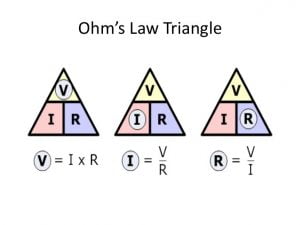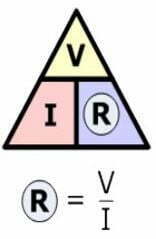What is Ohm’s Law?
Ohm’s Law Calculator
Use the Ohm’s Law Calculator to quickly and easily calculate the voltage, current, resistance, and power in an electric circuit.
Enter the values for two of the variables, and the calculator will solve for the third:
Answer:
The History of Ohm’s Law

In 1826, Georg Simon Ohm discovered a relationship between the current flowing through a conductor and the voltage applied to it. This relationship is now known as Ohm’s law, and it is the foundation of modern electrical engineering.
Ohm’s law states that the current flowing through a conductor is proportional to the voltage applied to it. In other words, if you double the voltage, the current will also double.
This relationship is represented by the following equation:
I = V/Rwhere I is the current (in amperes), V is the voltage (in volts), and R is the resistance (in ohms).
The Basics of Ohm’s Law
As we just learned, Ohm’s law states that there is a linear relationship between voltage and current in all conductors. This means that if you know two of these quantities, you can always calculate the third using the following equation:
V = IRwhere V is the voltage (in volts), I is the current (in amperes), and R is the resistance (in ohms).


This equation is known as the “voltage equation” because it allows you to calculate the voltage across a conductor if you know the current and resistance.
Similarly, there are two other equations that can be derived from Ohm’s law:
These equations are known as the “current equation” and “resistance equation,” respectively.
Together, these three equations are known as Ohm’s law.
Now that we know the basics of Ohm’s law, let’s see how it can be applied in practice:
Ohm’s Law in Practice
Suppose you have a light bulb that is powered by a 12-volt battery. The light bulb has a resistance of 2 ohms.
Using Ohm’s law, we can calculate the current flowing through the light bulb as follows:
I = V/R → I = 12V/2Ω → I = 6 amps
We can also calculate the voltage across the light bulb:
V = IR → V = 6A × 2Ω → V = 12 volts
Finally, we can calculate the resistance of the light bulb:
R = V/I → R = 12V/6A → R = 2 ohms
How to Use Ohm’s Law
The Formula for Ohm’s Law
The most basic form of Ohm’s law states that the voltage (V) across a circuit is equal to the current (I) times the resistance (R). This can be written as:
V = I x R
This equation is known as the “Ohm’s law formula” It is important to note that this formula is only valid if the circuit is operating in a linear fashion. Non-linear circuits, such as those found in electronic devices, will not obey this formula.
How to Apply Ohm’s Law
Now that we know the basics of Ohm’s law, let’s see how it can be applied in practice. Suppose we have a simple electric circuit consisting of a battery and a light bulb. We can use the Ohm’s law formula to determine how much current will flow through the circuit.
First, we need to determine the voltage of the battery. This is typically printed on the battery itself, and will be either 1.5 volts or 3 volts for common household batteries. Next, we need to determine the resistance of the light bulb. This information can usually be found on the packaging of the light bulb, and is typically around 10 ohms. Armed with this information, we can now plug into our equation:
I = 0.15 amps
This tells us that the current flowing through our circuit will be 0.15 amps. We can now use this information to determine the power (P) of the circuit, using the formula:
P = 0.225 watts
As you can see, Ohm’s law can be a very useful tool for understanding and calculating the behavior of electric circuits.
The Benefits of Knowing Ohm’s Law
Ohm’s Law Can Help You Save Money
Ohm’s Law Can Help You Avoid Electrical Hazards
Ohm’s law can also help you avoid electrical hazards. For example, if you know that a certain appliance needs 10 amps of current to operate safely, you can check the wiring to make sure it can handle that much current. If the wiring can’t handle that much current, it could overheat and start a fire.
Ohms Law Books and Reference Guides:
In conclusion, Ohm’s Law is a fundamental law of electricity that is essential for understanding how electric circuits work. It can also be used to save money and avoid electrical hazards. If you need help understanding or applying Ohm’s Law, there are many resources available online and in libraries.
Useful Resources
Electrical Resistance: How It Works